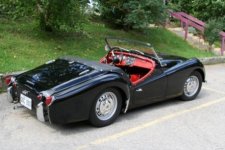Don, the control head was not on the car when we got it, so while the steering wheel was removed from the car I repainted the wheel - masked the chrome sprayed, etc. Came out nice. My problem was that the wheel itself was a bit bent and had a few cracks. I've been told that the wheel core is an aluminum rod in a circle. We put it on a nice flat bench, bent things until the main shaft was 90 degrees to the wheel, and then carefully bent portions of the wheel rim up or down until it laid nice and flat against the bench top. Used a dremel to buff out the chrome rods. After that I epoxied any cracks I found and then bought a black leather stitched cover and stitched it on.
While I had the control head apart I used some soft metal polish and a buffing wheel and used short stints (2-3 seconds) on the wheel to buff out the black plastic (bakelite?) head and chrome trim. Was careful not to leave it on the wheel long enough to heat it up too much. Worked like a champ, and now looks brand new.

 Hi Guest!
Hi Guest!

 smilie in place of the real @
smilie in place of the real @
 Pretty Please - add it to our Events forum(s) and add to the calendar! >>
Pretty Please - add it to our Events forum(s) and add to the calendar! >> 
